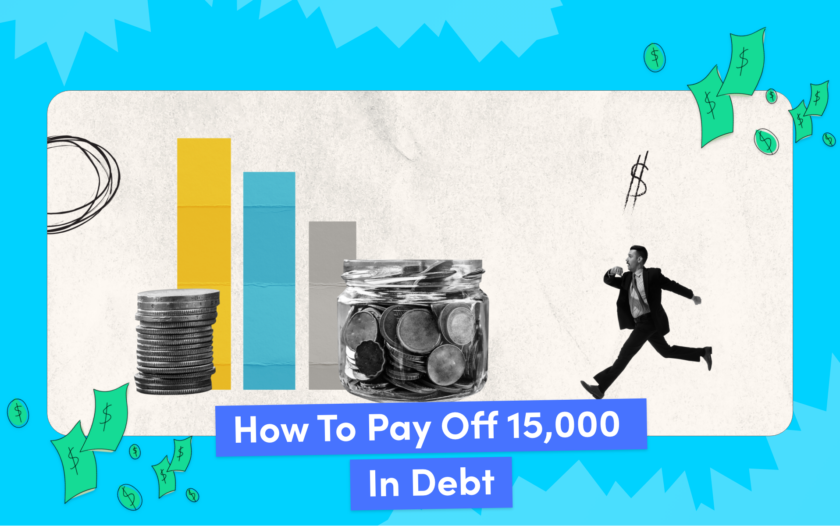4 Ways to Pay Off $15,000 Debt
About Caitlyn
Caitlyn is a freelance writer from the Cincinnati area with clients ranging from digital marketing agencies, insurance/finance companies, and healthcare organizations to travel and technology blogs. She loves reading, traveling, and camping—and hanging with her dogs Coco and Hamilton.
Read full bio
At a Glance
Dealing with a substantial debt of $15,000 can be daunting, but there are effective strategies to regain financial control. This article explores four prominent ways to tackle this debt, providing insights into debt relief programs, home equity loans, 401(k) loans, and balance transfer credit cards. Additionally, we delve into other practical tips and lifestyle changes to expedite the debt repayment process.
In this article, you’ll learn:
Debt relief program
1. Debt consolidation loan
One method to manage and reduce debt is through a debt consolidation loan. This approach involves combining multiple debts into a single, more manageable loan with a potentially lower interest rate. By streamlining payments, you can simplify your financial obligations and focus on repaying the consolidated amount. You’ll also be able to pay off your debt faster.
Debt consolidation loans are particularly beneficial for those struggling with high-interest credit card debt. With a consolidated loan, you’ll likely secure a lower interest rate, reducing the overall cost of repayment.
Find and compare the best debt consolidation loan options.
Use the filters below to refine your search

Sorry, we didn’t find any options that meet your requirements. Please try modifying your preferences.
Congratulations! You’re close to seeing your offers!
Please take a second to review the details you shared earlier
Sorry, we didn’t find any options that meet your requirements. Please try modifying your preferences.
2. Debt settlement service
Another alternative is enrolling in a debt settlement service. These programs negotiate with creditors on your behalf to settle debts for less than the total amount owed. Typically, you’ll engage with a debt settlement company that will assess your financial situation, including the debt you owe, your income, and other factors. Then, they will reach out and negotiate with your creditors to settle the debt for a reduced amount.
Once the settlement is reached, you must make payments directly to the debt settlement company. The payments will be put into an escrow account, and the debt settlement company will use those funds to pay the creditors.
While debt settlement can result in lower payments, it may negatively impact your credit score and involve fees.There’s also no guarantee the creditors will agree to a settlement.
3. Debt management program
A debt management program (DMP) is a structured plan to repay debts, typically facilitated by non-profit credit counseling agencies. In a DMP, the agency negotiates with creditors to lower interest rates and consolidate payments. You’ll make a single monthly payment to the agency, which then distributes the funds to creditors.
DMPs are beneficial for those struggling to manage multiple debts and seeking professional assistance. However, it’s essential to choose a reputable credit counseling agency and carefully review the terms of the program.
Take home equity loan to minimize interest
Another avenue to consider is leveraging your home’s equity with a home equity loan (HEL). An HEL allows you to borrow against the equity in your home, providing a lump sum that can be used to pay off high-interest debts, such as credit card balances.
By using your home as collateral, you may secure a lower interest rate compared to credit cards. However, this approach comes with risks – failure to repay a home equity loan can lead to foreclosure. It’s crucial to assess your financial stability and commitment to repayment before pursuing this option.
Learn More: Home Equity Loans
401(k) loan
For those with a retirement savings account, a 401(k) loan can be a viable option. This involves borrowing against your 401(k) savings to pay off existing debts. Typically you can borrow as much as 50% of your savings (or up to $50,000). While this method allows you to access funds quickly, it comes with potential drawbacks.
Borrowing from your 401(k) may incur taxes and penalties if not repaid within a specific timeframe. Additionally, the borrowed amount is no longer invested, potentially impacting your retirement savings. Before considering a 401(k) loan, carefully weigh the consequences and explore alternative options.
Related: Should You Use a 401(k) Loan to Pay Off Debt?
Balance transfer credit card
Transferring high-interest credit card balances to a card with a lower or 0% introductory APR can be an effective strategy for debt repayment. The 0% intro APR allows you to carry a balance for a certain period of time (typically 12-24 months) without accruing interest charges, allowing you to focus on paying down the principal amount.
However, it’s crucial to be aware of the terms and fees associated with balance transfers. Some cards may charge a balance transfer fee, and the introductory APR period is finite. Additionally, missing payments or not fully repaying the balance within the promotional period could result in higher interest rates.
Compare: Balance Transfer Credit Cards
Other tips to pay off debt
1. Create your own budget plan
Developing a personalized budget plan is crucial for effective debt management. Analyze your income, expenses, and debt obligations to create a realistic budget. Identify areas where you can cut back on spending and allocate more funds toward debt repayment.
2. Pay double the minimum
Paying only the minimum amount due prolongs the repayment process and increases overall interest costs. Whenever possible, try to pay double the minimum or more. This accelerates debt payoff and minimizes accrued interest.
3. Stop charging
To make significant progress in paying off debt, resist the temptation to accumulate more. Stop using your credit cards for non-essential purchases and focus on reducing existing balances. Note that closing your credit card can damage your credit score, but avoiding using the card for unnecessary expenses will prevent additional debt.
4. Lifestyle changes to cut-off extra expenses
Evaluate your lifestyle and identify areas where you can cut unnecessary expenses. This might involve dining out less, finding more affordable entertainment options, or renegotiating subscription services. Redirecting these savings toward debt repayment can expedite the process.
Bottom line
Effectively managing and paying off a $15,000 debt requires a strategic approach tailored to individual circumstances. Whether through debt relief programs, home equity loans, 401(k) loans, or balance transfer credit cards, each method has its pros and cons. Additionally, adopting smart financial habits, such as creating a budget, paying more than the minimum, and curbing unnecessary expenses, contributes to a successful debt repayment journey.
FAQs
The time it takes to pay off a $15,000 credit card debt depends on several factors, including the interest rate, the amount of monthly payments, and any additional contributions made to accelerate the payoff. To estimate the time needed to pay off a $15,000 credit card debt, you can use online calculators that consider interest rates, monthly payments, and additional contributions. It’s important to note that making only minimum payments can significantly extend the repayment period, potentially taking several years to pay off the entire debt.
The average credit card debt in America is about $5,000 so $15,000 is considered above average, but what might be considered “normal” can vary based on your individual financial circumstances. While some people may have $15,000 in credit card debt due to temporary financial challenges, others may be consistently carrying high balances, which could negatively impact their financial health and long-term goals. If you find yourself with a significant amount of credit card debt, it’s advisable to seek financial advice, create a realistic budget, and develop a plan to pay down the debt efficiently. Additionally, consulting with a financial advisor or credit counselor can provide personalized guidance based on your specific circumstances.
Minimum payments are typically 2% or 3% of the outstanding balance, so the minimum payment would likely be $300 or $450.
Paying off $15,000 in debt within one year requires a focused and disciplined approach to budgeting and debt repayment.
- Assess your financial situation: Review your current income, expenses, and debt obligations. Understand the interest rates on your debts, especially if you have multiple sources of debt.
- Create a realistic budget: Develop a detailed budget that includes all of your monthly income and expenses. Identify areas where you can cut back on non-essential spending to free up more money for debt repayment.
- Prioritize high-interest debt: If you have multiple debts, prioritize paying off those with the highest interest rates first. This is often referred to as the debt avalanche method.
- Explore additional income: Consider finding ways to increase your income, such as taking on a part-time job, freelancing, or selling unused items.
- Negotiate interest rates: Contact your creditors to negotiate lower interest rates. This can significantly reduce the overall cost of repaying the debt.
- Consider debt consolidation: Explore the option of consolidating your debts into a single loan with a lower interest rate. This can simplify payments and reduce overall interest costs.
- Avoid taking on new debt: Commit to not accumulating new debt during this period. Cut up or put away credit cards to avoid temptation.
- Seek professional advice: If you’re struggling, consider seeking advice from a financial advisor or credit counselor. They can provide personalized guidance based on your situation.









